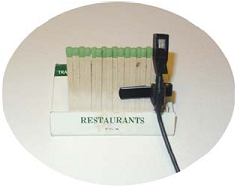
Products
Accelerometers |Microphones | nVision | CHARM | Mini Acoustic Chambers | BARS | VibroFibre | ME'scope | Insect Vibration
Accelerometers |Microphones | nVision | CHARM | Mini Acoustic Chambers | BARS | VibroFibre | ME'scope | Insect Vibration
Bay Systems Microphones
Microphones | Radio Link | Wind Noise | Tyre Cavity Microphone
Microphones
The microphones and pre-amplifiers offered are designed to fill an obvious gap that exists in the microphone market today.
| Laboratory grade microphones with their associated pre-amplifier are available from reputable sources and usually have the following features: - | The real world is a far different environment to the laboratory and the BAY SYSTEM Microphones are suitable for this more robust environment : - |
| 1. The assembled microphone capsule and pre-amp will be quite heavy typically weighing 100g and be 7 cm long. Supporting it requires care and a robust clamp. | 1. Attach the 5 gram microphone using a tie clip. |
| 2. It will be corrected for diffraction and other effects and be ideal for one of the following conditions : - Free field, Diffuse field or pressure field. Usually you can use the microphone, with suitable correction in any environment. |
2. The microphone is set up for a diffuse field and this is what most rooms and cabins are. |
| 3. They are expensive > $1000 | 3. The microphone costs < $200 and the pre-amp a similar amount and it is separated from the microphone by 3 metres of thin light cable. This means that the microphone can be replaced for $200. |
| 4. They do not like to get wet | 4. Soak the microphone in a bucket of water; dry it with a hair dryer and it will be working fine. |
| 5. They do not like to get hot > 50 deg C. | 5. It will work to specification to 60 degrees C and will still work at 125 degrees but be 3 dB out. It will recover from being exposed to 125 degrees and work normally. |
| 6. They are very accurate. | 6. Frequency response is flat to +/- 1 dB from 40Hz to 10kHz and +/- 5dB 20Hz to 20kHz. Most mechanical noise is within the 40 to 10kHz band and most results are quoted with a weighting factor. This means that even though the Bay microphone is not in theory suitable as a microphone for use with a Class 1 sound level meter the results obtained for overall A weighted level will be identical in 99% of cases. |
| 7. They are normally required to be inspected and given a broad range frequency calibration annually. | 7. No inspection or calibration is necessary as there is no delicate diaphragm to damage. |
| 8. You normally calibrate them before use with a calibrator costing approximately $500 | 8. The calibrator costs a little less but not much though it will do the BAY, 1”, ½” and ¼” microphones. |
 | |